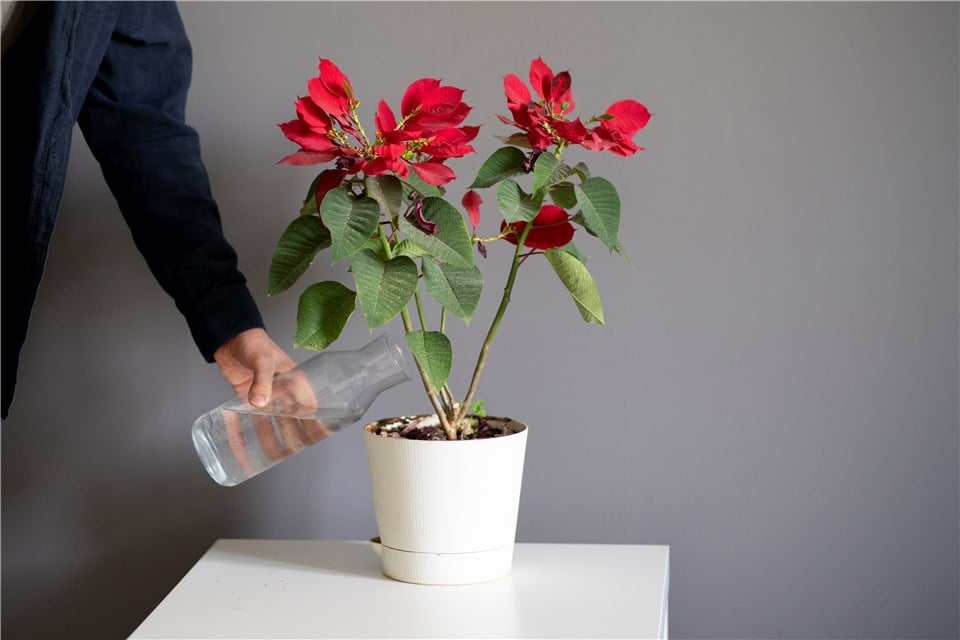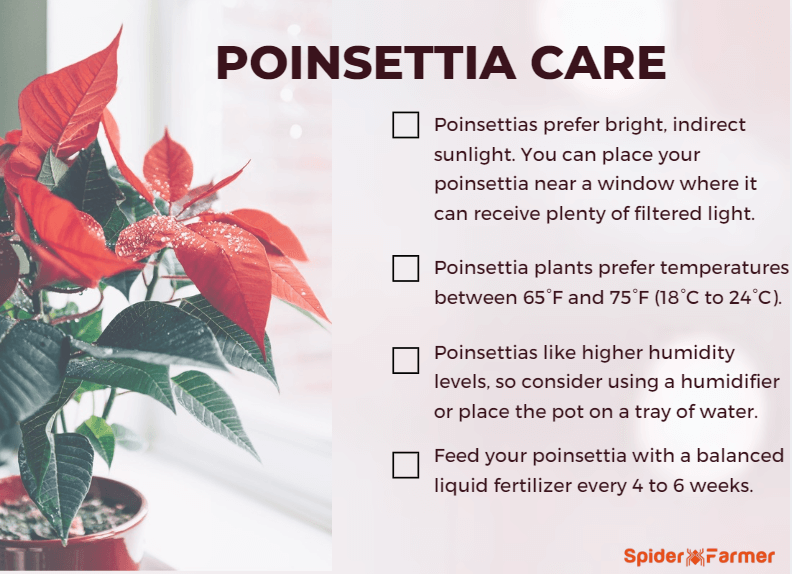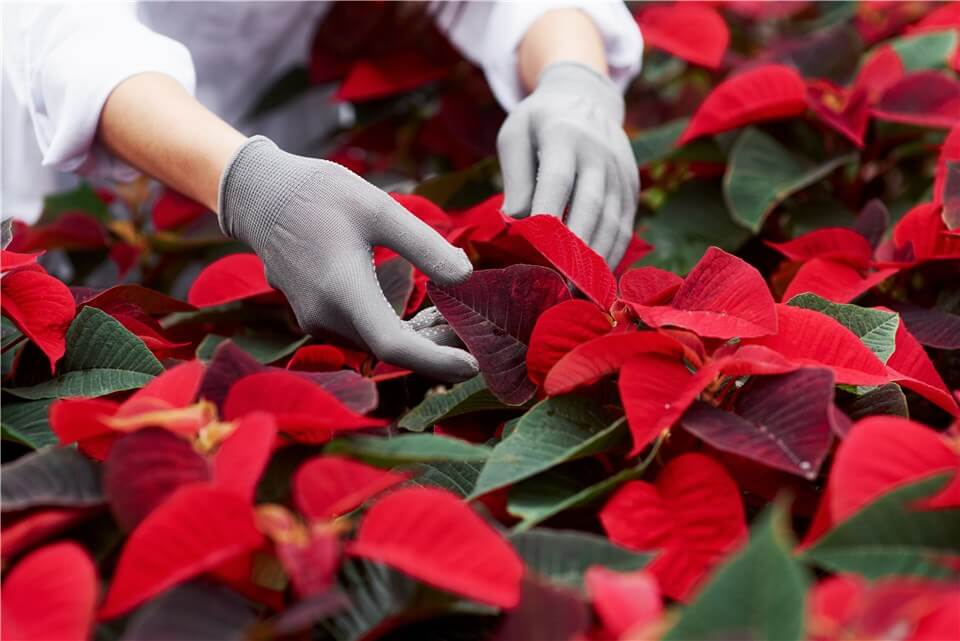Poinsettias are popular holiday plants famous for their vibrant red and green foliage. Typically, they can last for about 6 to 8 weeks during their peak blooming period, which usually occurs from late November through January.
When it comes to Poinsettia care indoors, you may wonder how often you should water a poinsettia. Poinsettias need moderate watering, typically requiring enough water to thoroughly moisten the soil without creating soggy conditions. Except for adequate watering, light control and temperature monitoring can keep your poinsettias healthy and vibrant for several months. With proper care, many poinsettias can survive for years if cared for correctly after the blooming period, but they may not bloom again until the next holiday season. Follow the tips in this article, you can enjoy your poinsettia long after the holidays are over.
Table of Contents
How Often to Water Poinsettias?
Generally, you should water your Poinsettia when the top inch of the soil feels dry to the touch. This typically means watering every 1 to 2 weeks, but factors such as humidity, temperature, and pot size can influence this schedule. During warmer months, you may need to water more frequently, while cooler indoor conditions may require less.
When growing and taking care of Poinsettias, you should pay attention to the signals of your Poinsettias. Yellowing leaves may indicate overwatering while drooping or wilting leaves can suggest underwatering. Therefore, you can’t overwater a poinsettia. Always ensure your pot has drainage holes to prevent waterlogging, which can lead to root rot.
How to Water Poinsettias?
When watering Poinsettias, water thoroughly until it drains out of the bottom of the pot, which will ensure the roots receive adequate moisture. Besides, it’s essential to avoid overwatering, as this can lead to root rot; always use pots with drainage holes to prevent water accumulation. If your poinsettia is in a decorative pot without drainage, consider removing it during watering, allowing it to drain completely before placing it back. Regularly check the soil and adjust your watering schedule based on environmental factors like humidity and temperature to keep your poinsettia healthy and vibrant.

How Often to Water Poinsettias?
Why Is My Poinsettia Wilting?
Recently, many gardeners have been asking why their Poinsettias are wilting. Factors such as watering frequency, temperature fluctuations, humidity levels, nutrients, and pests may all cause this problem. Check the list below and learn how to care for your Poinsettias.
- Watering Issues: Either underwatering or overwatering can cause stress.
- Temperature Fluctuations: Extreme temperatures or drafts can harm the plant.
- Low Humidity: Poinsettias prefer higher humidity levels.
- Nutrient Deficiency: Lack of essential nutrients can weaken the plant.
- Pest Infestation: Pests like aphids or mealybugs can cause wilting.
- Natural Lifecycle: Post-holiday, the plant may shed leaves as part of its cycle.
How to Care for a Poinsettia?
It is easy to take care of a poinsettia plant. These vibrant plants require minimal attention, as they can thrive in bright indirect light and need water only when the top inch of soil feels dry. They prefer temperatures between 65°F and 75°F and benefit from occasional fertilization. With just a little care regarding their light and watering needs, you can enjoy a healthy and beautiful poinsettia throughout the holiday season and beyond. Except for watering frequency, you can also care for poinsettias from the following aspects.

How to Care for a Poinsettia?
Poinsettia Light Requirements
Poinsettias need sunlight to thrive. They prefer bright, indirect sunlight, which helps maintain their vibrant colors and promote healthy growth. Ideally, place your poinsettia near a window where it can receive plenty of filtered light, but be sure to avoid direct sunlight, as it can scorch the leaves. Also, you can put poinsettias under an LED grow light. Providing the right amount of light will help your poinsettia flourish and extend its blooming period.
Poinsettia Temperature and Humidity Requirements
Poinsettia plants prefer temperatures between 65°F and 75°F (18°C to 24°C). Keep them away from drafts and sudden temperature changes. Poinsettias also benefit from higher humidity levels, so consider using a humidifier or placing the pot on a self-watering system to maintain moisture.
Poinsettia Fertilization Requirements
Feed your poinsettia with a balanced liquid fertilizer every 4 to 6 weeks, starting in spring after the blooming period. This will provide essential nutrients to support healthy growth.
FAQs About Poinsettia Plants
By the end of the post, we’ll answer several questions about Poinsettia plants.
Can poinsettias be outside?
Poinsettias can be placed outside, but they are sensitive to cold temperatures and should only be outdoors in warmer climates. Ideally, they thrive in temperatures between 65°F and 75°F (18°C to 24°C). If you live in USDA hardiness zones 9 to 11, you can keep poinsettias outside year-round, provided they are in a sheltered location that receives bright, indirect sunlight. However, if temperatures drop below 50°F (10°C), it's best to bring them indoors to prevent damage from the cold. Always acclimate them gradually to outdoor conditions to minimize stress.

Can Poinsettias be Outside?
On the contrary, Poinsettias should not be outside in the cold or exposed to cold temperatures, as they are sensitive to frost and can suffer damage if the temperature drops below 50°F (10°C). If you live in a region with cold winters, it's best to keep poinsettias indoors where they can thrive in a warm environment. If you want to place them outside during warmer months, ensure they are in a sheltered spot that receives bright, indirect sunlight. Always bring them indoors before temperatures drop to protect them from cold stress and potential damage.
How to make a poinsettia turn red?
To make a poinsettia turn red, you need to manipulate its light exposure to trigger the blooming process. Start by ensuring your poinsettia receives bright, indirect light during the day. Then, beginning in late September, provide the plant with 14 hours of complete darkness each night for about 8 weeks. This can be achieved by placing it in a dark room or covering it with a box. After this period, return it to bright light, and you should see the bracts (the colorful parts) begin to turn red as the plant prepares for its blooming season. Consistent care, including proper watering and fertilization during this time, will also support vibrant color development.
How long do pointsettiea leaves stay red?
Poinsettia leaves, or bracts, typically stay red for about 6 to 8 weeks during their peak blooming period, which occurs from late November through January. With proper care, including adequate light and watering, the vibrant color can last longer, sometimes extending into early spring. After this period, the leaves may gradually fade as the plant enters a rest phase. To encourage the brightest colors for the longest time, it's important to provide optimal growing conditions.
Why is my poinsettia dropping leaves?
Your poinsettia may be dropping leaves for several reasons. The most common causes include:
- Overwatering: Excess moisture can lead to root rot, causing the leaves to yellow and fall off. Ensure that the soil dries slightly between waterings and check for proper drainage.
- Underwatering: Conversely, if the plant is not receiving enough water, it can also lead to leaf drop. Make sure to water when the top inch of soil feels dry.
- Temperature Changes: Poinsettias prefer stable temperatures between 65°F and 75°F (18°C to 24°C). Cold drafts, heat sources, or sudden temperature fluctuations can stress the plant and cause leaves to drop.
- Low Humidity: These plants thrive in higher humidity. Dry indoor air, especially in winter, can lead to leaf loss.
- Light Conditions: Insufficient light can weaken the plant, leading to leaf drop. Ensure your poinsettia is placed in bright, indirect light.






























